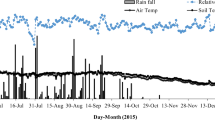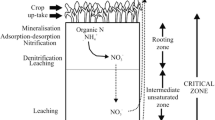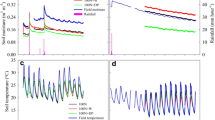Abstract
Ammonia volatilization losses and other N transformations were studied in drill sown rice bays fertilized with urea at various times between permanent flooding (PF) and panicle initiation (PI). Ammonia loss was measured directly with flow chambers and indirectly through application of Freney et al.'s (1985) model. Both techniques indicated that ammonia volatilization was negligible from fields fertilized immediately before PF. Applying 100 kg urea-N ha−1 to floodwater one day after flooding significantly increased floodwater ammoniacal-N and urea-N content, however the concentrations fell rapidly over the following five days. Fertilizer-N dissolved in the floodwater was in the urea rather than the ammoniacal-N form, indicating slow hydrolysis until it moved into the soil. Floodwater on plots receiving urea one day after PF frequently had more than double the NO3-N concentration of plots fertilized before flooding.
Applying up to 140 kg urea-N ha−1 at PI increased floodwater ammoniacal-N concentrations from almost zero to over 27 g m−3, but three days after fertilization there was less than 3 g m−3 present. Fertilization also increased NH4-N concentration in the top 40 mm of soil. Higher ammoniacal-N concentration at PI suggests higher urease activity. Floodwater pH at PI was low, with a mean daily maximum of 7.8 and this reduced ammonia loss to less than 1% of the applied N.
The results indicate that volatilization from fields fertilized prior to PF is minimal because of the low floodwater pH and ammoniacal-N concentration, while low floodwater pH restricts volatilization from fields topdressed at PI.
Similar content being viewed by others
References
Bacon PE (1985) The effect of nitrogen application time on Calrose rice growth and yield in south-eastern Australia. Aust J Exp Agric 25: 183–190
Bacon PE and Heenan DP (1984) Response of Inga rice to application of nitrogen fertilizer at varying growth stages. Aust J Exp Agric Anim Husb 24: 250–254
Bacon PE, McGarity JW, Hoult EH and Alter D (1986) Soil mineral nitrogen concentration within cycles of flood irrigation: Effect of rice stubble and fertilization management. Soil Biol Biochem 18: 173–178
Bacon PE and Heenan DP (1987) Nitrogen budgets for intensive rice growing in southern Australia. In Efficiency of Nitrogen fertilizer for Rice. IRRI Los Banos Philippines pp 89–96
Best EK (1976) An automated method for determining nitrate nitrogen in soil extracts. Qld Dept of Prim Ind Div of Plant Ind Bull 33
Brandon DM, Laing TR, Leonards WJ, Rawls SM and Simoneaux NG (1982) Timing of basal N fertilizer in relation to permanently flooding drill seeded rice in northeast Louisiana. 74th Ann Prog Rep Rice Exp Stn Crowley Louisiana US pp 108–113
Bray RH and Kurtz LT (1945) Determination of total, organic, and available forms of phosphorus in soils. Soil Sci 59: 39–45
Craswell ET and Vlek PLG (1983) Fate of fertilizer nitrogen applied to wetland rice. In Freney JR and Simpson JR eds. Caseous loss of nitrogen from plant-soil systems, pp 237–264. The Hague Martinus Nijhoff/Dr W Junk
Denmead OT, Freney JR and Simpson JR (1982) Dynamics of ammonia volatilization during furrow irrigation of maize. Soil Sci Soc of Am J 46: 149–155
Denmead OT (1983) Micrometerorologial methods for measuring gaseous losses of nitrogen in the field. In Freney JR and Simpson JR eds. Gaseous loss of nitrogen from plant—soil systems, pp 133–158. The Hague. Martinus Nijhoff/Dr W Junk
Douglas LA and Bremner JM (1970) Extraction and colorimetric determination of urea in soils. Soil Sci Soc Am Proc 34: 859–862
Fillery IRP, Simpson JR and De Datta SK (1984) Influence of field environment and fertilizer management on ammonia loss from flooded soil. Soil Sci Soc of Am J 48: 914–920
Fillery IRP and Vlek PLG (1986) Reappraisal of the significance of ammonia volatilization as an N loss mechanism in flooded rice fields. In De Datta SK and Patrick WH eds. — Nitrogen economy of flooded rice soils. pp 79–98. Dordrecht Netherlands. Martinus Nijhoff Pub
Freney JR, Denmead OT, Watanabe I and Crasswell ET (1981) Ammonia and nitrous oxide losses following applications of ammonium sulphate to flooded rice. Aust J Agric Res 32: 37–45
Freney JR, Leuning R, Simpson JR, Denmead OT and Muirhead WA (1985) Estimating ammonia volatilization from flooded rice fields by simplified techniques. Soil Sci Soc of Am J 49: 1049–1054
Humphreys E, Muirhead WA, Melhuish FM and White RJG (1987a) Effects of time of urea application on combine-sown Calrose rice in south-east Australia. I. Crop response and N uptake. aust J Agric Res 38: 101–112
Humphreys E, Muirhead WA, Melhuish FM, White RJG, Chalk PM and Douglas LA (1987b) Effects of time of urea application on combine-sown Calrose rice in south-east Australia. II. Mineral nitrogen transformations in the soil—water system. Aust J Agric Res 38: 113–127
Humphreys E, Chalk PM, Muirhead WA, Melhuish FM and White RJG (1987c) Effects of time of urea application on combine-sown Calrose in south-east Australia. III. Fertilizer nitrogen recovery, efficiency of fertilization and soil nitrogen supply. Aust J Agric Res 38: 129–138
McGarity JW and Rajaradnam JA (1973) Apparatus for the measurement of losses of nitrogen as gas from the field and simulated field environments. Soil Biol Biochem 5: 121–131
Mikkelsen DS, De Datta SK and Obcemea WN (1978) Ammonia volatilization losses from flooded rice soils. Soil Sci Soc of Am J 42: 725–730
Northcote KH (1979) A factural key for the recognition of Australian Soils 2nd Ed. Glenside SA Australia: Rellim Pubs
Reddy KR and Patrick WH Jr (1986) Denitrification losses in flooded rice fields. In De Datta SK and Patrick WH eds, Nitrogen economy of flooded rice soils. pp 99–115 Dordrecht Netherlands: Martinus Nijhoff Pub
Simpson JR, Freney JR, Wetselaar R, Muirhead WA, Leuning R and Denmead OT (1984) Transformations and losses of urea nitrogen after application to flooded rice. Aust J Agric Res 35: 189–200
Soil Survey Staff (1975) Soil taxonomy. Agricultural Handbook No. 436 USDA US Government Printing Office Washington DC
Van Dijk DC (1961) Soils of the southern portion of the Murrumbidgee Irrigation Areas. CSIRO Australia, Soils and Land Use Series No. 40
Ventura WB and Yoshida T (1977) Ammonia volatilization from a flooded tropical soil. Plant and Soil 46: 521–531
Vlek PLG and Craswell ET (1979) Effect of nitrogen source and management on ammonia volatilization losses from flooded rice-soil systems. Soil Sci Soc of Am J 43: 352–358
Author information
Authors and Affiliations
Rights and permissions
About this article
Cite this article
Bacon, P.E., Hoult, E.H., Lewin, L.G. et al. Ammonia volatilization from drill sown rice bays. Fertilizer Research 16, 257–272 (1988). https://doi.org/10.1007/BF01051375
Issue Date:
DOI: https://doi.org/10.1007/BF01051375




